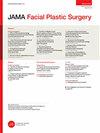Measuring Outcomes of Mohs Defect Reconstruction Using Eye-Tracking Technology.
Q1 Medicine
引用次数: 13
Abstract
Importance Objectively measuring how Mohs defect reconstruction changes casual observer attention has important implications for patients and facial plastic surgeons. Objective To use eye-tracking technology to objectively measure the ability of Mohs facial defect reconstruction to normalize facial attention. Design, Setting, and Participants This observational outcomes study was conducted at an academic tertiary referral center from January to June 2016. An eye-tracking system was used to record how 82 casual observers directed attention to photographs of 32 patients with Mohs facial defects of varying sizes and locations before and after reconstruction as well as 16 control faces with no facial defects. Statistical analysis was performed from November 2018 to January 2019. Main Outcomes and Measures First, the attentional distraction caused by facial defects was quantified in milliseconds of gaze time using eye tracking. Second, the eye-tracking data were analyzed using mixed-effects linear regression to assess the association of facial defect reconstruction with normalized facial attention. Results The 82 casual observers (63 women and 19 men; mean [SD] age, 34 [12] years) viewed control faces in a similar and consistent fashion, with most attention (65%; 95% CI, 62%-69%) directed at the central triangle, which includes the eyes, nose, and mouth. The eyes were the most visually important feature, capturing a mean of 60% (95% CI, 57%-64%) of fixation time within the central triangle and 39% (95% CI, 36%-43%) of total observer attention. The presence of Mohs defects was associated with statistically significant alterations in this pattern of normal facial attention. The larger the defect and the more centrally a defect was located, the more attentional distraction was observed, as measured by increased attention on the defect and decreased attention on the eyes, ranging from 729 (95% CI, 526-931) milliseconds for small peripheral defects to 3693 (95% CI, 3490-3896) milliseconds for large central defects. Reconstructive surgery was associated with improved gaze deviations for all faces and with normalized attention directed to the eyes for all faces except for those with large central defects. Conclusions and Relevance Mohs defects are associated with altered facial perception, diverting attention from valuable features such as the eyes. Reconstructive surgery was associated with normalized attentional distraction for many patients with cutaneous Mohs defects. These data are important to patients who want to know how reconstructive surgery could change the way people look at their face. The data also point to the possibility of outcomes prediction based on facial defect size and location before reconstruction. Eye tracking is a valuable research tool for outcomes assessment that lays the foundation for understanding how reconstructive surgery may change perception and normalize facial deformity.使用眼动追踪技术测量莫氏缺陷重建的结果。
重要的是客观地测量莫氏缺损重建如何改变观察者的注意力,对患者和面部整形外科医生有重要的意义。目的利用眼动追踪技术,客观评价莫氏面部缺损重建对面部注意力正常化的能力。设计、设置和参与者这项观察性结果研究于2016年1月至6月在一家学术三级转诊中心进行。眼睛跟踪系统用于记录82名临时观察者如何在重建前后将注意力集中在32名不同大小和位置的莫氏面部缺陷患者的照片上,以及16名没有面部缺陷的对照脸上。从2018年11月到2019年1月进行了统计分析。主要结果和测量首先,使用眼动追踪以凝视时间的毫秒为单位量化面部缺陷引起的注意力分散。其次,使用混合效应线性回归分析眼睛跟踪数据,以评估面部缺陷重建与标准化面部注意力的关系。结果82名随机观察者(63名女性和19名男性;平均[SD]年龄,34[12]岁)以相似和一致的方式观察对照面孔,大多数注意力(65%;95%置信区间,62%-69%)集中在包括眼睛、鼻子和嘴巴在内的中心三角形。眼睛是视觉上最重要的特征,在中心三角形内的注视时间平均为60%(95%置信区间,57%-64%),观察者总注意力平均为39%(95%可信区间,36%-43%)。莫氏缺陷的存在与这种正常面部注意力模式的统计学显著变化有关。缺陷越大,缺陷的位置越集中,观察到的注意力分散就越多,这是通过对缺陷的注意力增加和对眼睛的注意力减少来衡量的,范围从小周边缺陷的729(95%CI,526-931)毫秒到大中心缺陷的3693(95%CI 3490-3896)毫秒。重建手术与改善所有面部的凝视偏差有关,并与将注意力集中在眼睛上有关,除了那些有大中央缺陷的面部。结论和RelevanceMohs缺陷与面部感知的改变有关,转移了人们对眼睛等有价值特征的注意力。对于许多皮肤Mohs缺陷患者来说,重建手术与正常的注意力分散有关。这些数据对那些想知道重建手术如何改变人们看脸方式的患者来说很重要。数据还指出了在重建前基于面部缺陷大小和位置进行结果预测的可能性。眼动追踪是一种有价值的结果评估研究工具,为了解重建手术如何改变认知和使面部畸形正常化奠定了基础。
本文章由计算机程序翻译,如有差异,请以英文原文为准。
求助全文
约1分钟内获得全文
求助全文
来源期刊

JAMA facial plastic surgery
SURGERY-
CiteScore
4.10
自引率
0.00%
发文量
0
期刊介绍:
Facial Plastic Surgery & Aesthetic Medicine (Formerly, JAMA Facial Plastic Surgery) is a multispecialty journal with a key mission to provide physicians and providers with the most accurate and innovative information in the discipline of facial plastic (reconstructive and cosmetic) interventions.
 求助内容:
求助内容: 应助结果提醒方式:
应助结果提醒方式:


